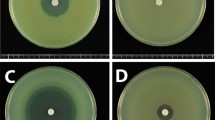Abstract
The double-disk synergy test (DDST) using Mueller-Hinton agar and antibiotic disks with centrally positioned disks of amoxicillin-clavulanate, ampicillin-sulbactam, and piperacillin-tazobactam and, at a center-to-center distance of 25–30 mm, 2–4 disks with 10 various β-lactam antibiotics per one plate was performed in 58 clinical isolates ofStenotrophomonas maltophilia to determine the effectivity of 3 β-lactamase inhibitors. When tested with clavulanate as the central β-lactamase inhibitor synergic action on tested strains was the most frequent with aztreonam (81.0 % of strains), cefoperazone (63.8 %), and cefepime (60.3 %). With sulbactam the synergic action,i.e. DDST positivity, was high in the case of cefoperazone (15.5 %), ampicillin, aztreonam and piperacillin (8.6 % each); with tazobactam it was the most frequent with aztreonam (53.4 %), cefoperazone (44.8 %) and cefepime (37.9 %). No synergy was demonstrated after application of meropenem regardless of the kind of β-lactamase inhibitor used. In 58 strains ofS. maltophilia, 55 different profiles of DDST positivity were found. The results confirm that clavulanate is the most effective inhibitor ofS. maltophilia β-lactamases. The utilization of DDST (performed in the recommended way) for the typization of strainsStenotrophomonas species and for the estimation of potential effectiveness combinations of β-lactams with β-lactamase inhibitors for the therapy of stenotrophomonade infections was suggested.
Similar content being viewed by others
Abbreviations
- DDST:
-
double-disk synergy test
- ESBL:
-
extended-spectrum β-lactamases
- β-lac:
-
β-lactamase
- Amp:
-
ampicillin
- Amx:
-
amoxicillin
- Azt:
-
aztreonam
- Cef:
-
cefepime
- Cfa:
-
ceftazidime
- Cfm:
-
cefpirome
- Cfp:
-
cefoperazone
- Cft:
-
ceftriaxone
- Cfx:
-
cefotaxime
- Cla:
-
clavulanate
- Mer:
-
meropenem
- Pip:
-
piperacillin
- Sul:
-
sulbactam
- Taz:
-
tazobactam
References
Blahová J., Králiková K., Krčmery V., Toršova V.: Transferable antibiotic resistance in nosocomialStenotrophomonas maltophilia strain.Diagn.Microbiol.Infect.Dis. 29, 129–132 (1997).
Blahová J., Hupková-Lešická M., Králiková K., Krčmery V.: Extended spectrum β-lactamase reactions inStenotrophomonas maltophilia.Infection 26, 187–188 (1998).
Cantón R., Valdezate S., Sanchez del Saz B., Perez-Vazquez M., Oliver A., Loza E., Baquero F.: Cef and β-lactamase inhibitor combinations against clinical isolates ofStenotrophomonus maltophila.Clin.Microbiol.Infect. 5 (Suppl. 3), 370 (1999).
Denton M., Kerr K.G.: Microbiological and clinical aspects of infection associated withStenotrophomonas maltophilia.Clin.Microbiol.Rev. 11, 57–80 (1998).
Felici A., Amicosante G.: Kinetic analysis of extension of substrate specifity withXanthomonas maltophilia, Aeromonas hydrophila, andBacillus cereus metallo-β-lactamases.Antimicrob.Agents Chemother. 39, 192–199 (1995).
Finkmann W., Altendorf K., Stackebrandt E., Lipski A.: Characterization of N2O-producingXanthomonas-like isolates from biofilters asStenotrophomonas nitritireducens sp nov.,Luteimonas mephitis gen.nov., sp.nov. andPseudoxanthomonas broegbernensis gen.nov., sp.nov.Internat.J.Syst.Evol.Microbiol. 50, 273–282 (2000).
Hejnar P., Chmela Z., Rypka M.: Fatty acid analysis ofStenotrophomonas maltophilia clinical strains showing different susceptibility to antibiotics at 30 and 37°C.Folia Microbiol. 47, 742–746 (2002).
Jarlier V., Nicolas M.H., Fournier G., Philippon A.: Extended broad-spectrum β-lactamases conferring transferable resistance to newer β-lactam agents inEnteropacteriaceae: hospital prevalence and susceptibility patterns.Rev.Infect.Dis. 10, 867–878 (1988).
Kelly M.D., Mortensen J.E., Konkle B.A., Stull T.L.: A plasmid mediating production of a β-lactamase byStenotrophomonas maltophilia.Curr.Ther.Res. 56, 152–162 (1995).
Muñoz Bellido J.L., García-Rodriguez J.A.: Azt-Cla synergy does not mean extended-spectrum β-lactamase inStenotrophomonas maltophilia.J.Antimicrob.Chemother. 41, 493–497 (1998).
Pankuch G.A., Jacobs M.R., Rittenhouse S.F., Appelbaum P.C.: Susceptibilities of 123 strains ofXanthomonas maltophilia to eight β-lactams (including β-lactam-β-lactamase inhibitor combinations) and ciprofloxacin tested by five methods.Antimicrob.Agents Chemother. 38, 2317–2322 (1994).
Paton R., Miles R.S., Amyes S.G.B.: Biochemical properties of inducible β-lactamases produced fromXanthomonas maltophilia.Antimicrob.Agents Chemother. 38, 2143–2149 (1994).
Payne D.J., Cramp R., Bateson J.H., Neall J., Knowles D.: Rapid identification of metallo- and serine β-lactamases.Antimicrob.Agents Chemother. 38, 991–996 (1994).
Pradhananga S.L., Rowling P.J.E., Simpson I.N., Payne D.J.: Sensitivity of L-2 type β-lactamases fromStenotrophomonas maltophilia to serine active site β-lactamase inhibitors.J.Antimicrob.Chemother. 37, 394–396 (1996).
Saino Y., Kobayashi F., Inoue M., Mitsuhashi S.: Purification and properties of inducible penicillin β-lactamase isolated fromPseudomonas maltophilia.Antimicrob.Agents Chemother. 22, 564–570 (1982).
Saino Y., Inoue M., Mitsuhashi S.: Purification and properties of an inducible cephalosporinase fromPseudomonas maltophilia GN 12873.Antimicrob.Agents Chemother. 25, 362–365 (1984).
Townsend R., Winstanley T.G., Spencer R.C.:In vitro susceptibility ofXanthomonas maltophilia to Azt and Cla as a test for the presumptive identification of the species.J.Hosp.Infect. 18, 324–325 (1991).
Valdezate S., Vindel A., Loza E., Baquero F., Cantón R.: Antimicrobial susceptibilities of uniqueStenotrophomonas maltophilia clinical strains.Antimicrob.Agents Chemother. 45, 1581–1584 (2001).
Author information
Authors and Affiliations
Corresponding author
Additional information
This work was supported by research project of theMinistry of Education, Youth and Sports of the Czech Republic no. MSM 151100002.
Rights and permissions
About this article
Cite this article
Hejnar, P., Kolár, M. & Chmela, Z. Double-disk synergy test positivity inStenotrophomonas maltophilia clinical strains. Folia Microbiol 49, 71–74 (2004). https://doi.org/10.1007/BF02931649
Received:
Issue Date:
DOI: https://doi.org/10.1007/BF02931649




